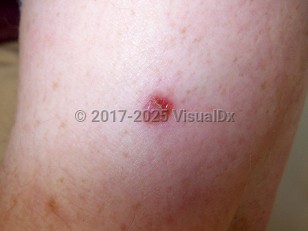Amelanotic melanoma in Adult
Alerts and Notices
Important News & Links
Synopsis

Amelanotic melanoma is a clinical subtype of cutaneous melanoma with little to no pigment on visual inspection. Amelanotic melanomas make up a small proportion of all melanomas, ranging from 2%-8% of all cases. Any subtype of melanoma can present as amelanotic; however, nodular melanomas and unclassified melanomas (including desmoplastic and subungual melanomas) are most commonly reported.
While no survival difference between pigmented and amelanotic melanomas is seen after correcting for American Joint Committee on Cancer (AJCC) tumor stage, amelanotic melanomas tend to be associated with a worse overall survival rate than the pigmented counterpart. This is thought to be from a delay in diagnosis, likely attributed to the difficulty in clinical diagnosis.
A 2017 study showed that an absence of back nevi, the presence of many freckles, a sun-sensitive phenotypic index, and/or prior amelanotic melanoma may increase the risk of developing amelanotic melanoma. According to a 2018 prospective cohort study in Australia, amelanotic melanoma is more common in chronically sun-exposed areas. In a large 2019 cross-sectional retrospective chart review study, amelanotic melanoma was found to be associated with the presence of red hair, older age, and a history of keratinocyte carcinomas, whereas it was found to have an inverse association with family history of melanoma, a prominent mole pattern (more than 50 nevi), and a history of dysplastic nevi.
While no survival difference between pigmented and amelanotic melanomas is seen after correcting for American Joint Committee on Cancer (AJCC) tumor stage, amelanotic melanomas tend to be associated with a worse overall survival rate than the pigmented counterpart. This is thought to be from a delay in diagnosis, likely attributed to the difficulty in clinical diagnosis.
A 2017 study showed that an absence of back nevi, the presence of many freckles, a sun-sensitive phenotypic index, and/or prior amelanotic melanoma may increase the risk of developing amelanotic melanoma. According to a 2018 prospective cohort study in Australia, amelanotic melanoma is more common in chronically sun-exposed areas. In a large 2019 cross-sectional retrospective chart review study, amelanotic melanoma was found to be associated with the presence of red hair, older age, and a history of keratinocyte carcinomas, whereas it was found to have an inverse association with family history of melanoma, a prominent mole pattern (more than 50 nevi), and a history of dysplastic nevi.
Codes
ICD10CM:
C43.9 – Malignant melanoma of skin, unspecified
SNOMEDCT:
276751004 – Amelanotic malignant melanoma of skin
C43.9 – Malignant melanoma of skin, unspecified
SNOMEDCT:
276751004 – Amelanotic malignant melanoma of skin
Look For
Subscription Required
Diagnostic Pearls
Subscription Required
Differential Diagnosis & Pitfalls

To perform a comparison, select diagnoses from the classic differential
Subscription Required
Best Tests
Subscription Required
Management Pearls
Subscription Required
Therapy
Subscription Required
References
Subscription Required
Last Reviewed:03/31/2019
Last Updated:07/28/2025
Last Updated:07/28/2025
Amelanotic melanoma in Adult

